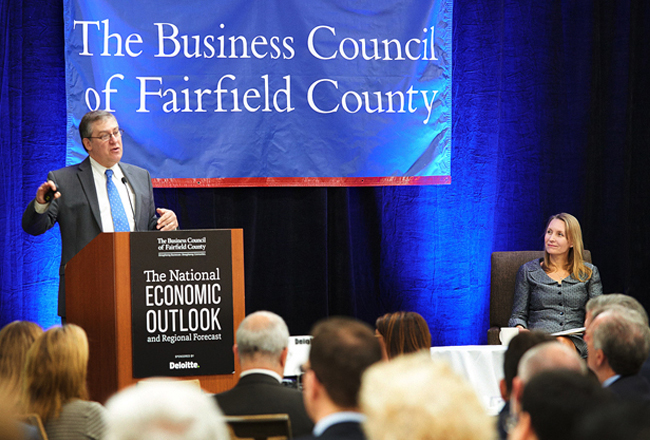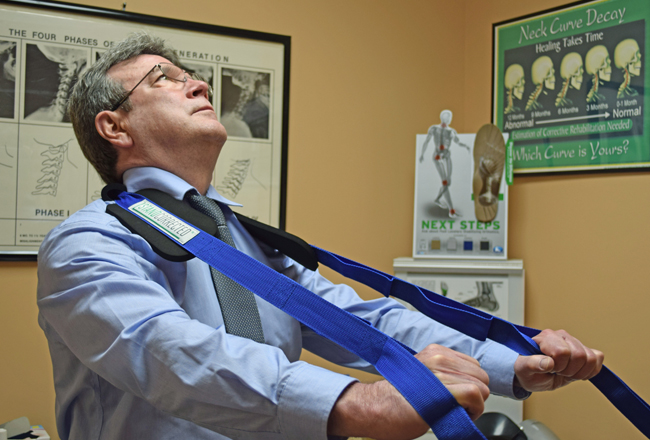An executive with the Federal Reserve Bank of New York told a group of Fairfield County businessmen on Feb. 28 that, while the county continues to lag much of the surrounding region and the nation at large in economic performance, it”™s doing better than Puerto Rico.

It was an inadvertent joke by the bank”™s Research Officer, Regional Analysis Jason Bram, whose purview includes New York state, southwestern Connecticut, and Puerto Rico ”“ something he sheepishly acknowledged in the wake of strained laughter from the crowd at the Sheraton Stamford hotel.
Speaking at the annual “National Economic Outlook and Regional Forecast,” presented by The Fairfield County Information Exchange ”“ an initiative of The Business Council of Fairfield County ”“ and sponsored by Deloitte, Bram nevertheless strove to paint a picture of the county that, if not brimming with overconfidence, at least indicated that things may not be as bad as they seem.
The U.S. experienced 3 percent growth in the second and third quarters of last year, and the Federal Reserve Bank of New York is forecasting 3.88 percent for the last quarter of 2017 and 3.2 percent for the first quarter of 2018. But while Fairfield County and Connecticut at large have continued to struggle, Bram ”” noting that he was speaking on his own behalf, not the Federal Reserve”™s ”” opined that as those larger economies continue to grow, the county and the state should eventually reap benefits.
Noting that Connecticut was one of just a handful of territories whose private-sector jobs were still down from the Great Recession as of December 2017 ”” the others being Alabama, West Virginia, Wyoming and Puerto Rico ”” Bram noted that the Nutmeg State”™s growth has risen to the “flat to 1.25 percent” category, putting it on par with 19 other states, including nearby New York and New Jersey. (Massachusetts is up 1.25-2 percent for the period.)
Employment-wise, the county remains sluggish, trailing not only New York City and the nation as a whole but also the Orange-Rockland-Westchester region. Bram noted that the farther one travels from Manhattan the worse private-sector job growth gets: Queens, Kings County (Brooklyn) and Rockland all saw growth of more than 2.5 percent during the first half of 2017, compared to the first six months of 2016, while Fairfield and Sussex counties both were down. Perhaps to spare feelings, no explanation was provided of just how “down” they were.
But Bram also had better news: the county”™s unemployment rate as of December 2017 was essentially on par with that of the U.S. and New York City, and far more commuters residing outside the county work here than vice-versa when it comes to New Haven County and “everywhere else”; county residents working in Westchester barely outnumber their opposite number, while those traveling to work in New York City are more than triple their counterpart.
Bram said that some optimism could be garnered from the fact that securities employment in Manhattan has slowed, with technology jobs taking up much of the slack ”” something that should help further boost the region at large.
Home prices have also picked up across much of the region, although Fairfield County”™s commercial and residential real estate markets have both been sluggish. That could change as Manhattan and Brooklyn rental and purchase prices continue to spiral upwards, he said.
The idea that young people only want work in a city “is not really true,” Bram counseled, saying that prices, culture, and other factors are still looked at by potential homeowners. “A lot of people still want to have a backyard,” he said.
Prefatory remarks at the event were made by Rey Giallongo, chairman and CEO, First County Bank and chairman, board of directors of The Business Council; Michael LaBella, market president ”” Connecticut, TD Bank and chairman, Fairfield County Information Exchange; and Heather Ziegler, Stamford managing partner, Deloitte.






















